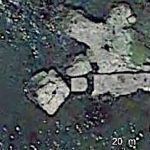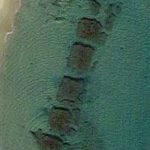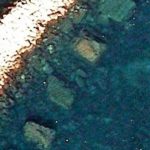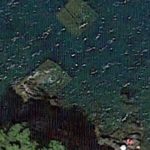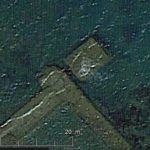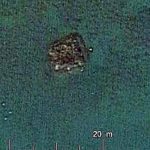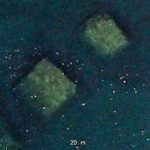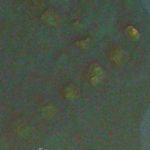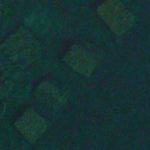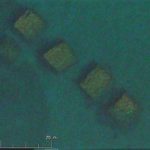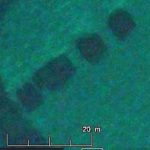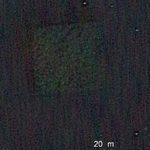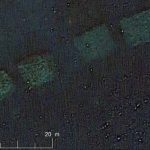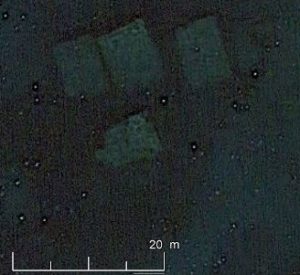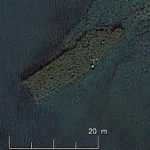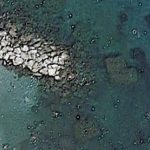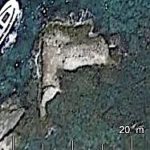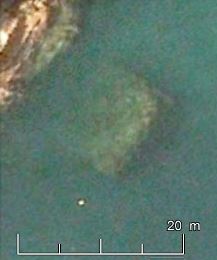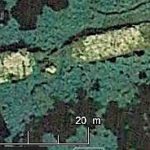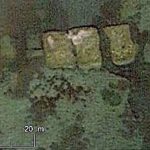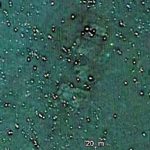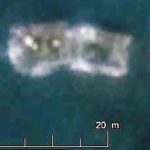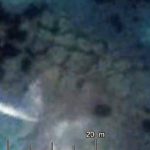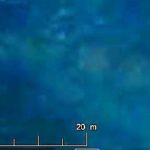Pilae are massive piles (opus pilarum), which are made of stone or concrete (opus caementicium). According to Oleson et al. (2014), the Latin word pila designates “a large mass of concrete, generally square in plan, and often a cube or upright rectangular prism in shape”[1].
Pilae have been used as a base for arched structures like aqueducts.
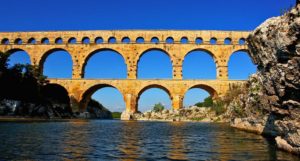
The ratio of opening between adjacent piers over pier width is as follows on the Pont du Gard:
- Upper level: opening = 1.4 pile widths
- Lower levels: opening = 4.1 pile widths
An arched breakwater looks like an aqueduct with a single tier. “Maritime pilae” are more “closed” than aqueducts, i.e. they have a smaller opening over pila-width ratio. This might be explained by their completely different aim which is not to support some kind of road or canal, but to stop wave penetration into the port while providing limited opening for water circulation supposed to reduce sedimentation inside the port, or at least in its entrance channel.
The method of construction of the submerged part of pilae with hydraulic concrete was described by Vitruvius and tested by Oleson et al. (2014) in Brindisi (see also Coulon & Golvin, 2020). The aerial part of pilae was made of traditional masonry or concrete without pozzolana.
Except in Civitavecchia, no ancient arched breakwater can be seen today, but remains of concrete pilae have been found in many places. A list is presented below, along with pictures of those that can be seen under water on Google Earth, some of which may be remains of arched breakwaters.
The following conclusions can be drawn:
- Most sites with one or more pilae are in Italy (35 out of 50), especially around Naples (25 sites from Caieta to Sapri), which is no wonder as the pozzolana required for under water pila construction originates from the area of Campi Flegrei.
- The average dimensions of the measured pilae are 9 m x 7 m: nearly square. The average horizontal surface is 68 m2. The height cannot be determined on Google Earth.
- The largest pila is the one found at Nesis: 14.5 x 14.5 x 8 m[2].
Various types of alignments can be distinguished from the pictures below:
- single isolated structures (e.g. Punta Fuenti, Fréjus, Caesarea Maritima, Alexandria-Antirhodos), possibly a foundation for some heavy structure such as a tower or lighthouse,
- rather continuous structures in the open sea, probably part of a vertical breakwater (e.g. Castellabate, Scidrus, Gnathia, Side, Psamathos, Caesarea Maritima),
- rather continuous structures in a sheltered area, perhaps forming a massive jetty or quay platform inside a harbour basin protected by a breakwater (e.g. Cosa, Neapolis, Horrea Caelia),
- pilae spaced with regular intervals (say 0.5 to 1.0 pila-width), perhaps the base of arched breakwaters or wooden decks, or intervals meant to be filled with rubble dumped into wooden formworks placed between the pilae (e.g. Caieta, Misenum, Baia, Portus Iulius, Nesis, Pausylipon, Civitavecchia, Alexandria-Qait Bey).
The pictures show that the distance between adjacent pilae is usually less than their width:
-
- Caieta: opening = 0.3 to 0.4 pila width
- Portus Iulius: opening = 0.7 pila width
- Misenum: opening = 1 to 1.5 pila widths
Several alignments of pilae have been claimed to be remains of arched breakwaters, including the Roman breakwaters at Tarragona[3] and Izmit[4], but little evidence was provided, except for Puteoli where many pictures are available, and Nisida with a picture from 1635, and Civitavecchia, which is still visible at Molo del Lazzaretto where arches seem to have been placed on top of a rocky shoal with an opening ratio is ca. 0.7.
The most famous ancient arched breakwater is at Puteoli (Pozzuoli). Some arches were still in place in the early 19th c., but the structure was gradually destroyed after that. Paolo Antonio PAOLI produced a detailed drawing in 1768 showing 15 pilae (including 2 supposed pilae, but the inscription CIL X 1641 dated 139 AD, mentions 20 pilae, Oleson, 2014, p 24). The largest pilae of ca. 15 x 15 m were at the offshore end of the structure. The nearshore pila was somewhat smaller: ca. 8 x 12 m. The opening ratio between adjacent pilae varied from 0.5 to 0.9, which is close to the values found for Portus Iulius and Misenum.
Concerning Portus Claudius’ north mole, Nero’s coins might point towards an arched breakwater as the water flow between piers is clearly shown on the right side of the coin.
One last note on arched breakwaters concerns the “Mosaico parietale con scena di porto” which was found at Palazzo Rospigliosi on the Quirinal Hill in Rome:
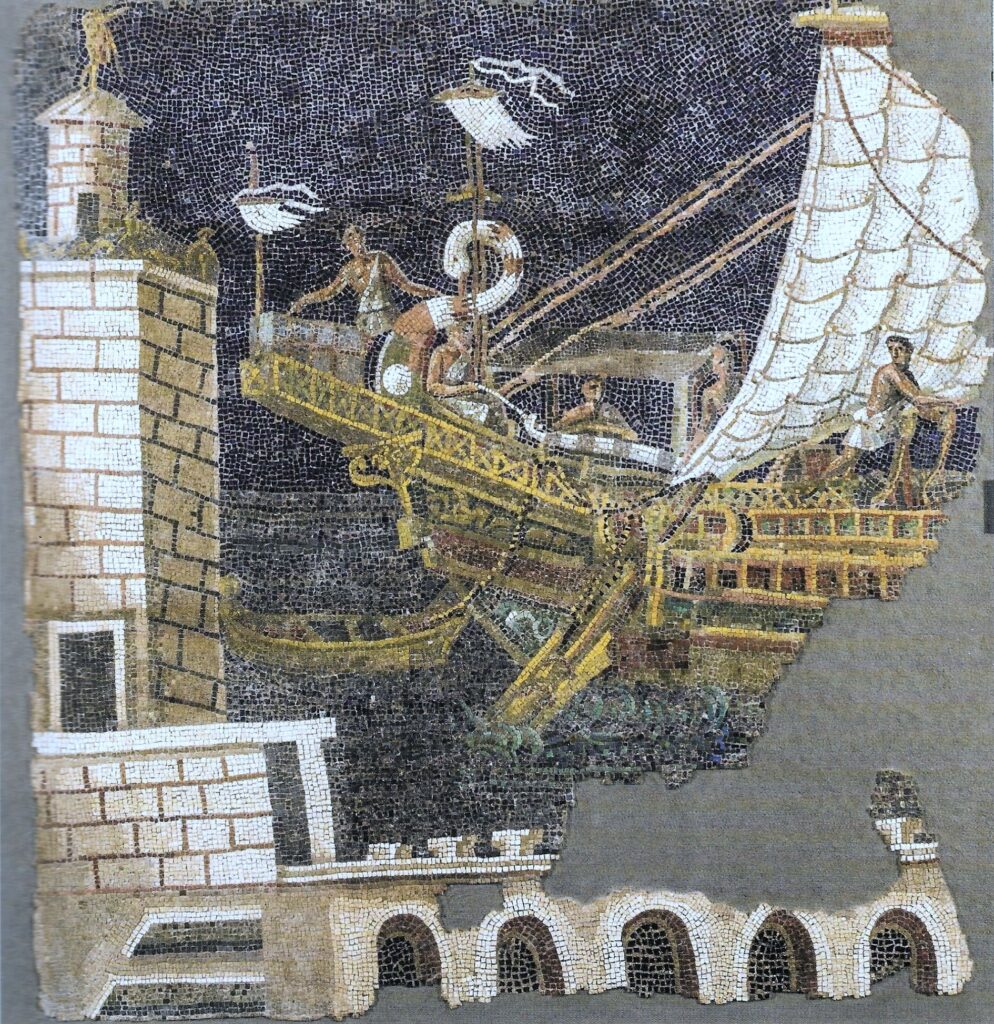
The arched structure shown at the lower side of the mosaic clearly is a quite massive arched structure which looks like an arched breakwater, rather than a portico. As it was found in Rome, one might ask whether this is not the north breakwater of Portus rather than a structure in Alexandria, which it is often supposed to be, or the Puteoli arched breakwater as the typical columns usually shown on that breakwater are not seen here.
References
[1] OLESON, J., BRANDON, C., HOHLFELDER, R., JACKSON, M., 2014, “Building for Eternity – The history and Technology of Roman Concrete Engineering in the Sea”, Oxbow Books, (327 p).
BRANDON, C., 2010, “How did the Romans form concrete underwater?”, Historic Mortars Conference, Prague.
BRANDON, C., 1996 « Cements, Concrete, and Settling Barges at Sebastos: Comparisons with Other Roman Harbor Exemples and the Descriptions of Vitruvius », in « Ceasarea Maritima, A Retrospective after Two Millennia », ed. A. Raban & K. Holum, Brill, Leiden, (p 25-40).
and also:
COULON, G., and GOLVIN, J-C., 2020, “Le Génie maritime romain”, Actes Sud/Errance, (201 p).
GIANFROTTA, P., 1996, “Harbor structures of the Augustan Age in Italy”, in “Ceasarea Maritima, A Retrospective after Two Millennia”, ed. A. Raban & K. Holum, Brill, Leiden, (p 65-76).
FELICI, E., 1998, “La Ricerca sui porti romani in cementizio: metodi a obiettivi”, Archeologia subacquea, (p 275-340).
FELICI, E., 2000, “Modern development and ancient maritime sites along the Tyrrhenian coast”, Coastal Management Sourcebooks, (p 81-88).
[2] MATTEI, G., TROISI, S., AUCELLI, P., PAPPONE, G., PELUSO, F., STEFANILE, M., 2018, “Sensing the Submerged Landscape of Nisida Roman Harbour in the Gulf of Naples from Integrated Measurements on a USV”, Water 2018, 10, 1686, (31 p).
[3] TERRADO, P., 2019, “El Puerto de Tarraco en Epoca Romana, (siglos II aC – III dC). Fuentes, historiografía y arqueología”, Autoritat Portuària de Tarragona y Arola Editors, (362 p), citing (p 177) Sanahuja (1859) telling about masses of hydraulic concrete, and citing (p 178) Echanove about arches. This ancient Roman breakwater was partly removed in 1843 and is now on land in a reclaimed area.
[4]TEXIER, C., 1839, “Description de l’Asie Mineure”, Nicomédie, (p 17-28), ed. Firmin Didot, Paris.
List of known pilae
Note that piles made of ashlar (e.g., Fossae Marianae piles) and made of masses of hydraulic concrete that are not nearly-cubic (e.g., breakwaters of Portus, Antium & Terracina, the wall at Les Laurons and numerous fish tanks-piscinae) are not listed hereunder.
| Ancient name | Modern name | Country | Length (m) | Width (m) |
| Tarraco, Tarrakon | Tarragona, Roman breakwater partly demolished in 1843 | Spain | ||
| Massalia Graecorum, Lacydon | Marseille, Vieux Port, place Jules Verne & place Villeneuve-Bargemon (see also nearby Musee des docks: Dolia warehouse) | France south | ||
| Forum Julii, Forum Julium | Roman naval base at Frejus, with a pila near the Lanterne d’Auguste | France south | 6.75 | 6.2 |
| Domitiana positio, Portus Domitianus | Roman villa at Santa Liberata, on the peninsula of Argentario | Italy west | 9-10 | 8 |
| Cosa, Cossae, Portus Herculis Cosanus, Etruscan Cusi, Cuthi | Ansedonia | Italy west | 6.5 | 6 |
| Centumcellae | Civitavecchia, Molo del Lazzaretto | Italy west | 5.3 | 11 |
| Astura, Storas | Torre Astura | Italy west | ||
| Port of Circei, Circe | inside Lago di Paola, with access via canal and breakwaters | Italy west | 6.5 | 6 |
| Caiete, Caieta, Caeatas, Etruscan Caithi | Spiaggia di Fontania, at Gaeta | Italy west | 6 | 5.5 |
| Misenos, Misenum, Misene | Punta Terrone, pilae of the southern breakwater | Italy west | 8-9 | 6-7 |
| Misenos, Misenum, Misene | Punta di Pennata, pilae of the northern breakwater | Italy west | 12 | 10 |
| Misenos, Misenum, Misene | Punta di Pennata, pilae within the harbour | Italy west | ||
| Castello Aragonese di Baia, is not a port (?) | Italy west | 8.5-10.5 | 7-7.5 | |
| Cantieri di Baia, is not a port (?) | Italy west | ca. 8 | ca. 7 | |
| Baiae, Baïes, Portus Baianus, with connection to Lacus Baianus | Baia, two concrete moles over 200 m long | Italy west | ||
| Villa dei Pisoni, is not a port (?) | Italy west | |||
| Secca Fumosa is not a port but some kind of platform, with opus reticulatum facing | Italy west | 8 | 8 | |
| Portus Iulius, Julius, port of Julien, with connection to Lacus Lucrinus | Lucrino, two concrete moles over 200 m long | Italy west | 8 | 8 |
| Portus Iulius, Julius, port of Julien, with connection to Lacus Lucrinus | East of eastern breakwater | Italy west | 5.5 | 5 |
| Puteoli, Dikaiarcheia, Dicearque, in the Campi Phlegraei volcano district | Pozzuoli, Pouzzoles, Puteoles, in the Campi Flegrei volcano district, pilae of arched mole are under modern breakwater | Italy west | 12-15 | 8-15 |
| Puteoli, Dikaiarcheia, Dicearque, in the Campi Phlegraei volcano district | Pozzuoli, Pouzzoles, Puteoles, east of modern breakwater | Italy west | 10 | 10 |
| Nesis | Nisida, very large pila of over 1500 m3, with opus reticulatum facing | Italy west | 14.5 | 14.5 |
| Imperial Villa of Pausilypon | Gaiola | Italy west | ||
| Imperial Villa of Pausilypon | Imperial Villa at Posillipo | Italy west | 10 | 7 |
| Imperial Villa of Pausilypon | Palazzo degli Spiriti | Italy west | 7.5 | 6 |
| Imperial Villa of Pausilypon | Pollion’s villa at Porto Marechiaro | Italy west | 14 | 5 |
| Imperial Villa of Pausilypon | Villa Rosebery | Italy west | ||
| Neapolis | Naples, Piazza Municipio, offshore Roman quay made with wooden caissons | Italy west | ||
| Capraria, Capreae insula | Bagni di Tiberio, near Marina Grande on the isle of Capri, with lighthouse at Villa Jovis | Italy west | 7 | 4 |
| Capraria, Capreae insula | Palazzo a Mare, near Marina Grande on the isle of Capri | Italy west | 11 | 8 |
| Capraria, Capreae insula | Scoglio del Monacone, near the isle of Capri | Italy west | ||
| Seirenoussai nesoi, Anthemoessa insulae, Anthemuse, possible Siren islands, no stopover for Odysseus | isola di Gallo Lungo | Italy west | ||
| Vietri | Punta Fuenti, near Vietri sul Mare | Italy west | 12 | 10 |
| San Marco di Castellabate | Italy west | ? | 4.5 | |
| Scidrus | Roman villa at Cammerelle, near Sapri | Italy west | 8 | 5.5 |
| Hadrianou Hormos, port of Lupiae, Miltopiae? | Porto Adriano, at San Cataldo near Lecce; concrete poured into ashlar cells | Italy Adriatic | ? | 12 |
| Gnathia | Egnazia, with several pilae, one with opus reticulatum facing | Italy Adriatic | 5 | 3.5 |
| port of Hatria, Adria | Torre del Cerrano, with several pilae | Italy Adriatic | ||
| Pyrassos, Thebai | Nea Anchialos | Greece NE | ||
| Skiathos, Southern Harbour | Skiathos, prefab blocks for quay wall | Greece Islands | ca. 1 | ca. 1 |
| Skiathos, Lazareta | Skiathos, jetty with ashlar on top of concrete foundation structure | Greece Islands | ||
| Constantinopolis: Boukoleon | Bukoleon Sarayi | Turkey, Bosphorus | ||
| Nea-Paphos, Paphos | Kato Paphos, with twin breakwater | Cyprus | ||
| Ephesos, Roman port | West side of Panayirdag hill, near Selcuk | TR: West | ||
| Side, Sida | Selimiye, with possible ancient lighthouse | TR: South | ? | 7.5 |
| Soles, Soli, Soloi, Pompeiopolis | Mezitli, west of Mersin; concrete poured into ashlar cells | TR: South | ? | 15 |
| Caesarea Palaestinae, Cesaree, Ace, Sebastos | Qesaria, Caesarea Maritima, Roman port of Herod, built from 22 to 15 BC, with Drusion lighthouse; concrete poured into wooden caissons | Israel | 14 | 7 |
| Apollonia, Sozousa | Arsuf | Israel | ||
| Alexandria, Portus Magnus and its Pharos, home port of Classis Alexandrina fleet | Alexandria, also called « Le Phare », The Pharos; concrete poured into wooden caissons | Egypt: Med Sea | 15 | 8 |
| Alexandria | Alexandria, SE of Fort Qait Bey | Egypt: Med Sea | ||
| Leptis Magna, Lepcis Magna, Lepcitani Septimiani | Leptis Magna, Lepcis Magna, with ancient lighthouse, on R Lebda | Libya | ||
| Thapsus | Ras Dimass, near Bekalta, south of Monastir, large breakwater of the south port, with concrete poured into wooden caissons & possible lighthouse | Tunisia | ||
| Horrea Caelia, Heraklea | Hergla | Tunisia | 3 | 3 |
| Carthago, Carthagine, Punic Qart Hadasht, Knyn, port of Salammbo | Carthago, commercial port, see also so-called “Neptune block” on the coast North of the ports | Tunisia | 18 | 9 |
| Thapsa, Tipasa | Tipaza, sheltered by two islets | Algeria | 10 | 3 |
| Psamathos | isle of Joinville in front of Cherchel, with ancient lighthouse | Algeria | 8 | 6 |
Pilae seen on Google Earth
